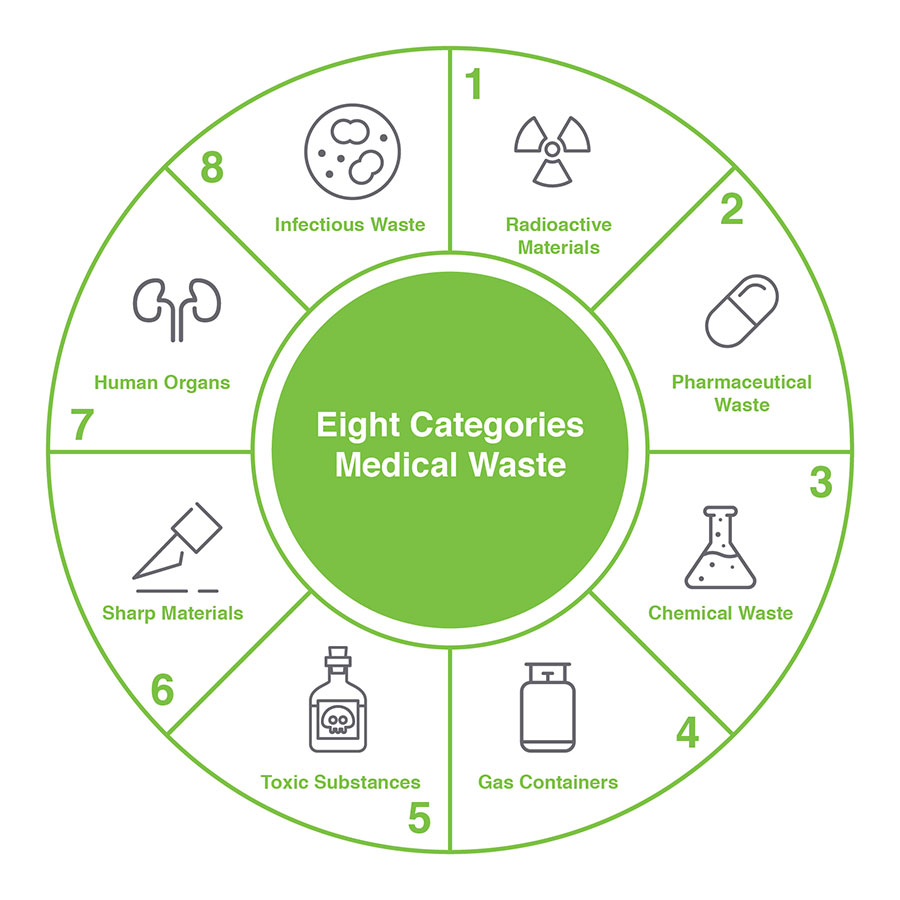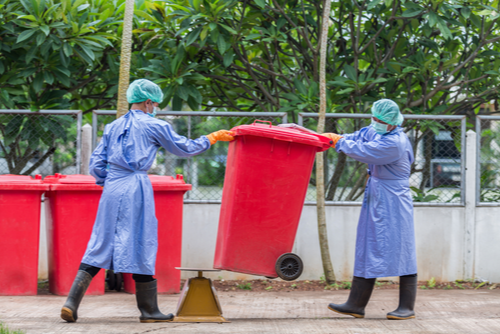Safety and security First: Your Overview to Accountable Medical Waste Removal Services
Safety and security First: Your Overview to Accountable Medical Waste Removal Services
Blog Article
The Significance of Correct Clinical Waste Disposal: An Overview for Medical Care Facilities
Appropriate medical waste disposal is an important aspect of medical care facility management, ensuring the safety and security and health of people, team, and the setting. From understanding the different categories of clinical waste to adhering to regulatory needs, health care centers need to adopt reliable waste segregation techniques and choose proper disposal methods. The value of proper medical waste disposal goes past plain compliance; it is an obligation that calls for ongoing training and education for personnel. In this overview, we will certainly explore the different elements of clinical garbage disposal and highlight the crucial steps that healthcare facilities must take. By implementing these practices, health care centers can minimize dangers, shield public health and wellness, and contribute to a cleaner, much safer setting.
Comprehending Medical Waste Categories
Understanding medical waste categories is essential for proper disposal in healthcare facilities. Clinical waste is a wide term that includes different sorts of waste generated in medical care setups, such as labs, hospitals, and clinics. Categorizing medical waste aids make sure that it is dealt with, saved, and disposed of securely and in conformity with applicable guidelines.
There are a number of categories of clinical waste that healthcare centers require to be knowledgeable about. These groups include contagious waste, sharps waste, pharmaceutical waste, chemical waste, and contaminated waste (medical waste disposal services with WasteX). Each group has particular qualities and requires different disposal methods to decrease the threat of injury to medical care employees, patients, and the setting
Infectious waste, for instance, refers to squander polluted with possibly infectious materials, such as blood, body fluids, and tissues. Pharmaceutical waste is composed of run out or unused medicines, while chemical waste is composed of dangerous chemicals used in medical procedures.
Conformity With Regulatory Demands
Health care facilities need to make certain conformity with governing demands for proper clinical garbage disposal. Governing bodies, such as the Epa (EPA) and the Occupational Safety And Security and Health Management (OSHA), have established guidelines and laws to protect public wellness and the atmosphere. These guidelines lay out the proper handling, storage space, transportation, and disposal of medical waste.
Conformity with governing needs is crucial for healthcare centers to avoid legal fines, reputational damage, and potential harm to human health and wellness and the environment. Failing to adhere to these policies can lead to penalties, lawsuits, and even the suspension or cancellation of operating licenses.
To make certain compliance, healthcare facilities ought to establish detailed waste administration programs that consist of personnel training, proper waste partition, and using appropriate containers and labels. Normal audits and inspections ought to additionally be conducted to recognize any type of non-compliance problems and resolve them promptly.
It is necessary for health care centers to keep up to date with adjustments in laws and upgrade their waste administration methods as necessary. This can be accomplished by actively keeping an eye on updates from governing bodies and joining training programs and workshops.
Applying Reliable Waste Partition Practices
To ensure proper medical garbage disposal, healthcare centers must implement reliable waste partition techniques. Waste partition is a critical action in the overall waste management process, as it aids minimize the risk of infection, protects against cross-contamination, and ensures the safe disposal of different sorts of waste. Efficient waste partition methods include dividing clinical waste right into various groups based upon its features and possible hazards.
One common method is the segregation of sharps waste, such as scalpels and needles, from various other sorts of medical waste. Sharps waste must be positioned in puncture-resistant containers to pop over to these guys avoid injuries and possible infections. In addition, contaminated materials, such as chemicals and pharmaceuticals, need to be separated from general clinical waste to stop environmental contamination.
Proper labeling and color-coding of waste containers are necessary for effective waste segregation. Visible and clear tags ought to be placed on each container to show the sort of waste it has and any kind of special delivery needs - medical waste disposal services with WasteX. Furthermore, color-coding can be utilized to distinguish in between different waste classifications, making it simpler for health care team to get rid of and identify of waste appropriately
Normal training and education for health care team is important for the effective application of waste partition methods. Personnel need to be educated on the different waste classifications, proper partition methods, and the importance of adhering to waste monitoring protocols. This will aid ensure conformity and consistency in waste segregation practices throughout the facility.
Deciding On Appropriate Disposal Approaches
Appropriate choice of proper disposal techniques is important in guaranteeing the safe and ecologically accountable administration of clinical waste in healthcare facilities. Medical care centers create a selection of clinical waste, consisting of sharps, contagious waste, pharmaceutical waste, and chemical waste - view medical waste removal near me. Each type of waste requires particular disposal methods to decrease the danger of contamination, injury, and environmental harm
One usual disposal technique for clinical waste is incineration. Incineration includes the regulated burning of waste at heats. This approach is reliable in ruining microorganisms and decreasing the quantity of waste. Nevertheless, it can release harmful contaminants right into the air otherwise appropriately managed.

Chemical sanitation is one more method made use of for particular kinds of clinical waste, such as pharmaceutical waste. This technique uses chemicals to counteract or ruin pollutants. Nonetheless, it is important to pick chemicals that are risk-free and eco-friendly.
Sometimes, garbage dump disposal may be appropriate for non-hazardous clinical waste (medical waste disposal services with WasteX). However, appropriate segregation and product packaging are critical to prevent leakage or contamination.
Inevitably, health care centers have to very carefully evaluate the characteristics of their clinical waste and choose proper disposal methods that prioritize safety and security, environmental management, and regulative compliance. Normal training and monitoring are important to ensure that medical care personnel adheres to correct disposal procedures.

Training and Educating Staff on Proper Disposal Procedures
Personnel education and learning and training play a critical role in making certain the correct disposal of clinical waste in medical care centers. It is important that all employee, consisting of physicians, registered nurses, service technicians, and assistance staff, obtain comprehensive training on appropriate disposal treatments. This training ought to cover the different sorts of clinical waste, their prospective dangers, and the appropriate methods for managing, setting apart, and dealing with them.
Among the main objectives of staff education and training is to make sure that all health care experts understand the importance of appropriate disposal treatments and the possible effects of inappropriate waste monitoring. They require to be familiar with the dangers associated with medical waste, such as the transmission of infections and the contamination of the atmosphere. medical waste removal service. By recognizing these dangers, team member will be much more determined to follow appropriate disposal protocols and take the required preventative measures to shield themselves, their coworkers, and the neighborhood
Training ought to likewise cover the use of personal safety equipment (PPE) and the appropriate techniques for managing medical waste. Team member must be informed on just how to determine and segregate various types of waste, such as sharps, infectious waste, and harmful chemicals. They must additionally be educated on the proper use waste containers, such as sharps containers and biohazard bags, as well as the value of labeling and sealing these containers correctly.
In addition, personnel education and training need to consist of normal updates and correspondence course to make sure that healthcare professionals stay notified about the current laws and best techniques in clinical waste disposal. This ongoing education and learning is crucial to keep a high degree of recognition and compliance among personnel participants.
Conclusion
In final thought, appropriate clinical waste disposal is of utmost significance for medical care facilities. Understanding the various groups of clinical waste and conforming with regulatory requirements makes certain the safety and Recommended Reading security and wellness of both medical care workers and the general public.
From understanding the different groups of clinical waste to complying with regulative requirements, health care facilities must take on efficient waste partition practices and pick appropriate disposal techniques. These categories include infectious waste, sharps waste, pharmaceutical waste, chemical waste, and radioactive waste.To make sure proper medical waste disposal, healthcare centers need to execute effective waste segregation techniques. Waste segregation is an important step in the total waste administration process, as it aids minimize the danger of infection, stops cross-contamination, and ensures the safe disposal of various types of waste. Medical care centers create a range of clinical waste, including sharps, transmittable waste, pharmaceutical waste, and chemical waste.
Report this page